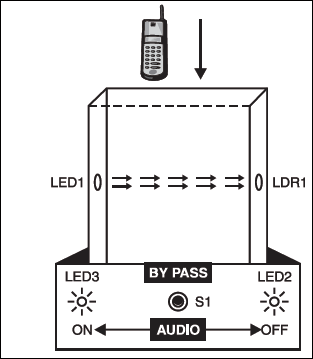 This cellphone controlled audio mute switch is highly useful in automobiles. The circuit automatically disconnects power supply to the audio/video system whenever the mobile handset is lifted off the holder for making or receiving a call. You can use any readily available cellphone holder with some minor alterations or fabricate it yourself as shown in Fig. 1.
This cellphone controlled audio mute switch is highly useful in automobiles. The circuit automatically disconnects power supply to the audio/video system whenever the mobile handset is lifted off the holder for making or receiving a call. You can use any readily available cellphone holder with some minor alterations or fabricate it yourself as shown in Fig. 1.
Cellphone controlled audio mute switch

The circuit is wired around IC LM555 (IC1), the CMOS version of timer NE555, as shown in Fig. 2. IC1 is used as a medium-current line driver with either an inverting or non-inverting output. It can sink (or source) current of up to 50 mA only, so take care while handling it. The audio/video system is connected to the circuit via normally opened (N/O) contacts of the relay.

When the cell phone is in its holder, LDR1 does not receive any light from white LED1 and its resistance is high. As a result, the voltage at pin 2 of IC1 remains high to provide a low output at pin 3. The low output of IC1 activates relay RL1 and the audio/video system gets power supply via its N/O contacts. LED3 glows to indicate that the audio/video system is ‘on.’When the handset is taken off the holder, light rays from LED1 fall on LDR1 and its resistance decreases. As a result, the voltage at pin 2 of IC1 decreases to provide a high output at its pin 3. The high output of IC1 deactivates relay RL1 and the audio/video system does not get power supply. LED2 glows to indicate that the audio/video system is ‘off.’
Preset VR1 is used to control the sensitivity of the circuit. Zener diode ZD1 is used for protecting white LED1 from the higher voltage. The circuit works off a 12V car battery. Switch S1 can be used to manually switch on/off the audio/video system.
The article was first published in June 2004 and has recently been updated.






